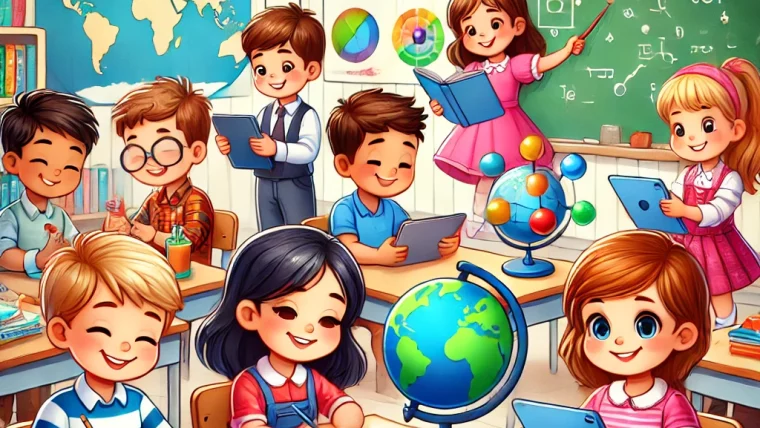
Last updated on 2024/01/27
Reading time : 8 minutes
The benefits of children’s stories !
Children’s stories are much more than just tales; they have always held a special place in educating and nurturing young minds.
Across generations, these captivating stories have the power to instill values, foster imagination, and enhance learning.
In this article, we delve into the numerous benefits of children’s stories and their significance in the development of young ones.

Children’s stories foster imagination and creativity :
Children’s stories often feature fantastical worlds, enchanted realms, distant planets, and uncharted territories. These imaginary worlds invite children to explore extraordinary places, discover fictional cultures, and dream of incredible adventures.
The characters in children’s stories are diverse and fascinating. They can be powerful wizards, brave princesses, formidable dragons, talking animals, and much more. These extraordinary characters inspire children to create their own heroes and heroines, invent fantastic characters, and explore unique aspects of personality.
The plots of children’s stories are often woven with challenges, quests, and adventures. Children are transported into narratives where they must solve puzzles, overcome obstacles, and face dangers. This encourages their analytical and problem-solving skills.
Exploring these imaginary worlds encourages children to think creatively. They can imagine new story endings, invent characters and places, or even create their own stories. This freedom to create and innovate enhances their creativity.
Children’s stories often raise philosophical and ethical questions. Children are exposed to moral dilemmas, abstract concepts, and ideas about life and the world around them. This prompts them to think and ask questions about important subjects.
Imagination is a powerful learning tool for children. Stories allow them to explore complex concepts in an accessible and engaging way, helping them develop their understanding of the world around them.
When stories are read in a family setting or shared among friends, they become opportunities for discussion and exchange. Children can ask questions, discuss character decisions, and express their ideas, further enriching their imaginative experience.
Children’s stories teach values and life lessons:
Children’s stories are often imbued with moral lessons and important values.
They highlight kindness as a crucial virtue. Kind and caring characters are often rewarded, while those who exhibit meanness or selfishness usually face negative consequences. Children thus learn the importance of treating others with respect and empathy.
The heroes and heroines of tales face challenges and obstacles. The courage they show in overcoming these difficulties inspires children to be brave in their own lives. They understand that fear is natural but can be overcome.
Stories often address the theme of friendship and cooperation. Children see how characters work together to solve problems and overcome obstacles. This encourages them to cultivate positive and benevolent relationships.
Generosity is also another common value in stories. Characters who share, are willing to help others, and show generosity are portrayed positively, teaching children to be generous towards others.
Many stories present situations where justice triumphs. Villains are punished, and the just are rewarded. This teaches children the importance of fairness and justice in society.
They also show the consequences of actions. Children see that the choices they make can impact their own lives and those of others. This encourages them to be responsible for their actions.
By following the adventures of story characters, children are exposed to a variety of emotions and perspectives. This helps them develop empathy towards others, understand their feelings, and learn to put themselves in others’ shoes.

They help develop your child’s language skills :
Early exposure to listening to stories helps children develop their language skills.
Indeed, stories present rich and diverse language. Children are exposed to a variety of words, phrases, and expressions they might not hear in their daily conversations. Stories follow grammatical and syntactical rules and have a clear narrative structure, with a beginning, middle, and end. This makes them excellent learning tools for grammar and syntax. Children also understand how stories are organized and how events unfold in a logical order. This promotes their understanding of narration.
This early exposure to varied vocabulary helps expand their lexical repertoire.
Moreover, when you read a story to your child, they may sometimes have to guess the meaning of certain words or phrases from the context. This strengthens their ability to understand the meaning of words based on the overall context of the story, a valuable skill for communication. They learn to listen attentively and follow a complex story, essential for strengthening their auditory comprehension.
Stories often pique children’s curiosity. They ask questions about the meaning of words, characters’ actions, and the story’s progression. This is active learning.
They foster empathy and understanding:
When children read or listen to stories, they often identify with the main characters.
They experience adventures through the eyes of these characters and sometimes even feel their emotions. This helps them empathize with others and understand what the characters feel.
Children’s stories explore a range of human emotions, including joy, sadness, anger, fear, and compassion. Children are exposed to these emotions through the characters, helping them recognize and understand these emotions in others.
Some characters may act antagonistically or resolve conflicts, overcome challenges. The narrative provides opportunities to understand their motivations, how they cope with different trials, and their perspectives. Children learn that people can have different viewpoints. This makes them reflect on these solutions and their consequences, encouraging them to think about ways to solve problems in their own lives empathetically and constructively.
After reading a story, you can encourage your child to discuss the story, its characters, and their emotions. This creates opportunities to express empathy, ask questions, and reflect on how they would react in similar situations.
Children’s stories encourage cultivating the joy of listening and reading :
When children are exposed to stories from a young age, it can instill in them a lasting love for stories. Captivating plots and imaginary adventures motivate them to discover new books and explore different literary genres.
This can also encourage them to become avid readers and enjoy the benefits of reading throughout their lives.
Children’s stories play a crucial role in the development of children, stimulating their imagination, teaching values, developing their language skills, fostering empathy, and cultivating the joy of reading. As parents, reading stories to children is a precious gift that will accompany them throughout their journey of discovering the world and themselves.



